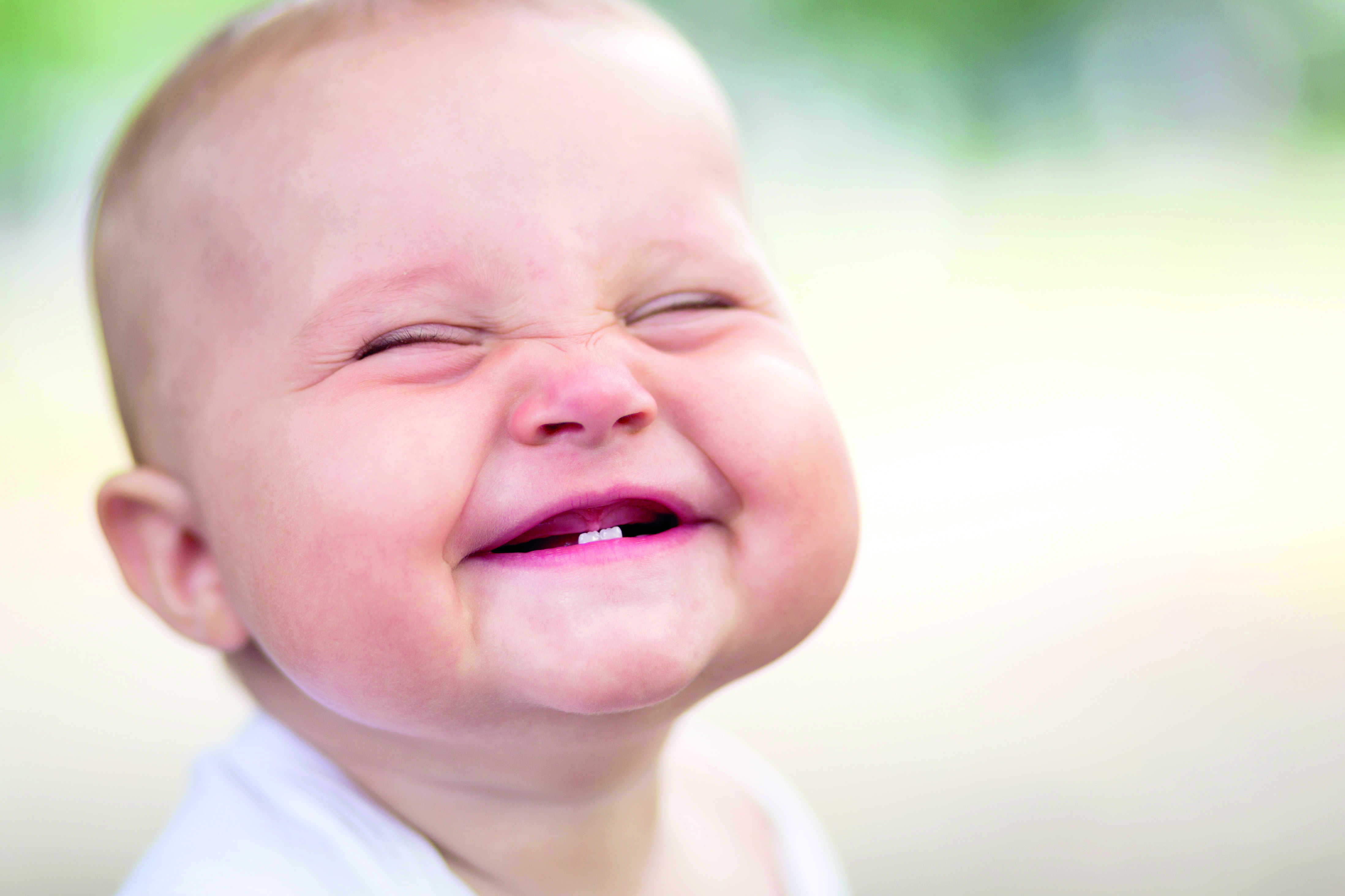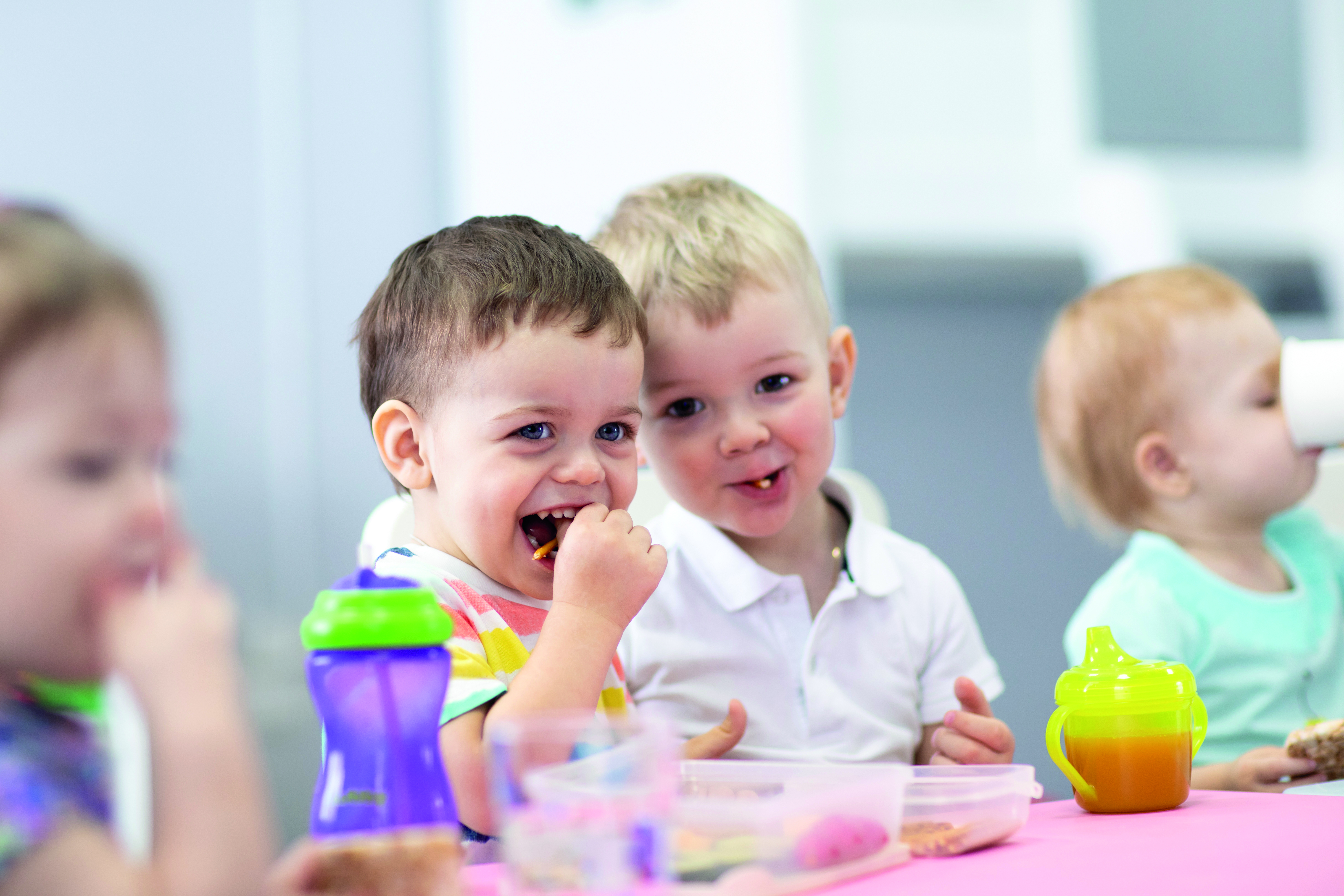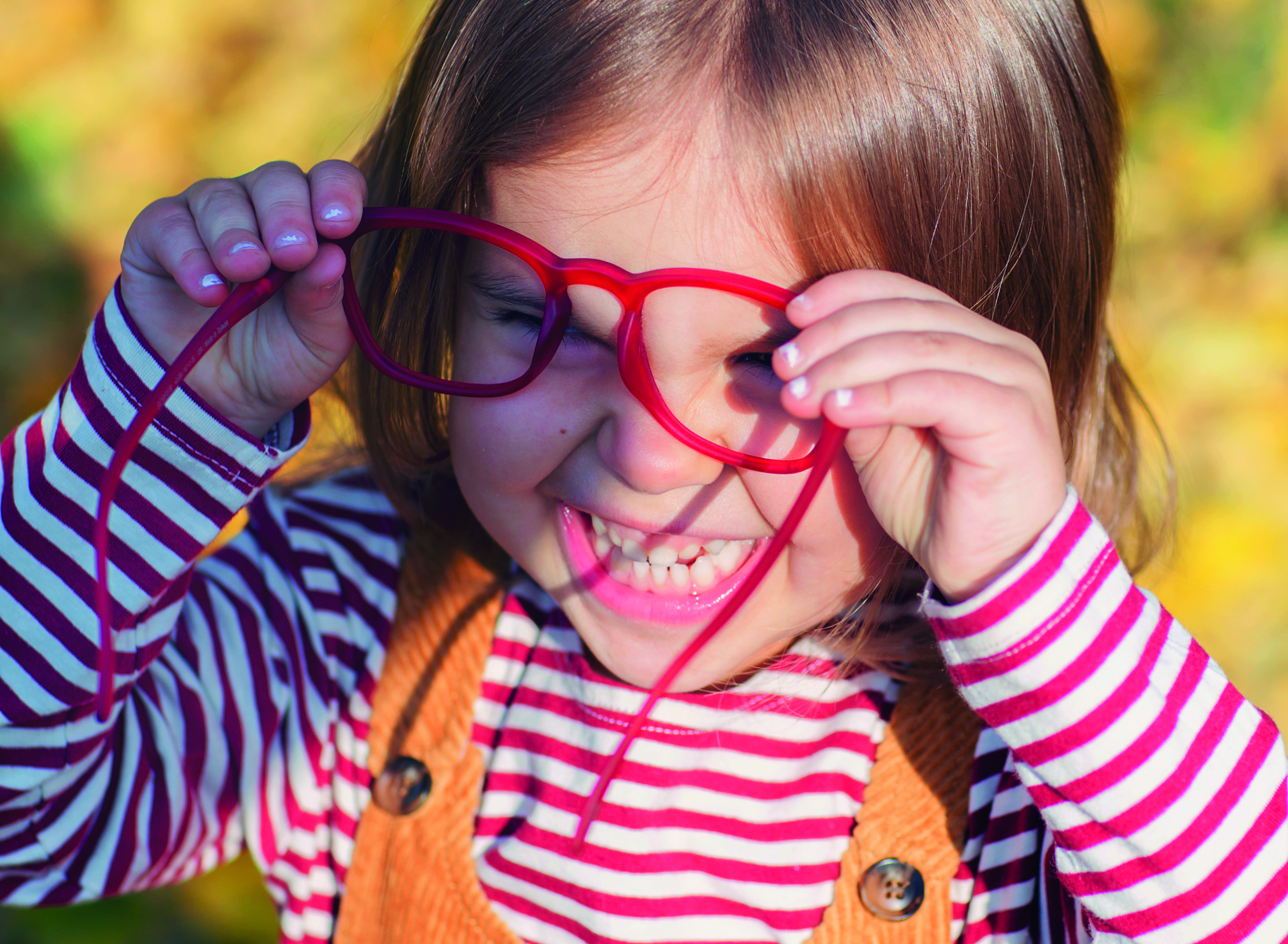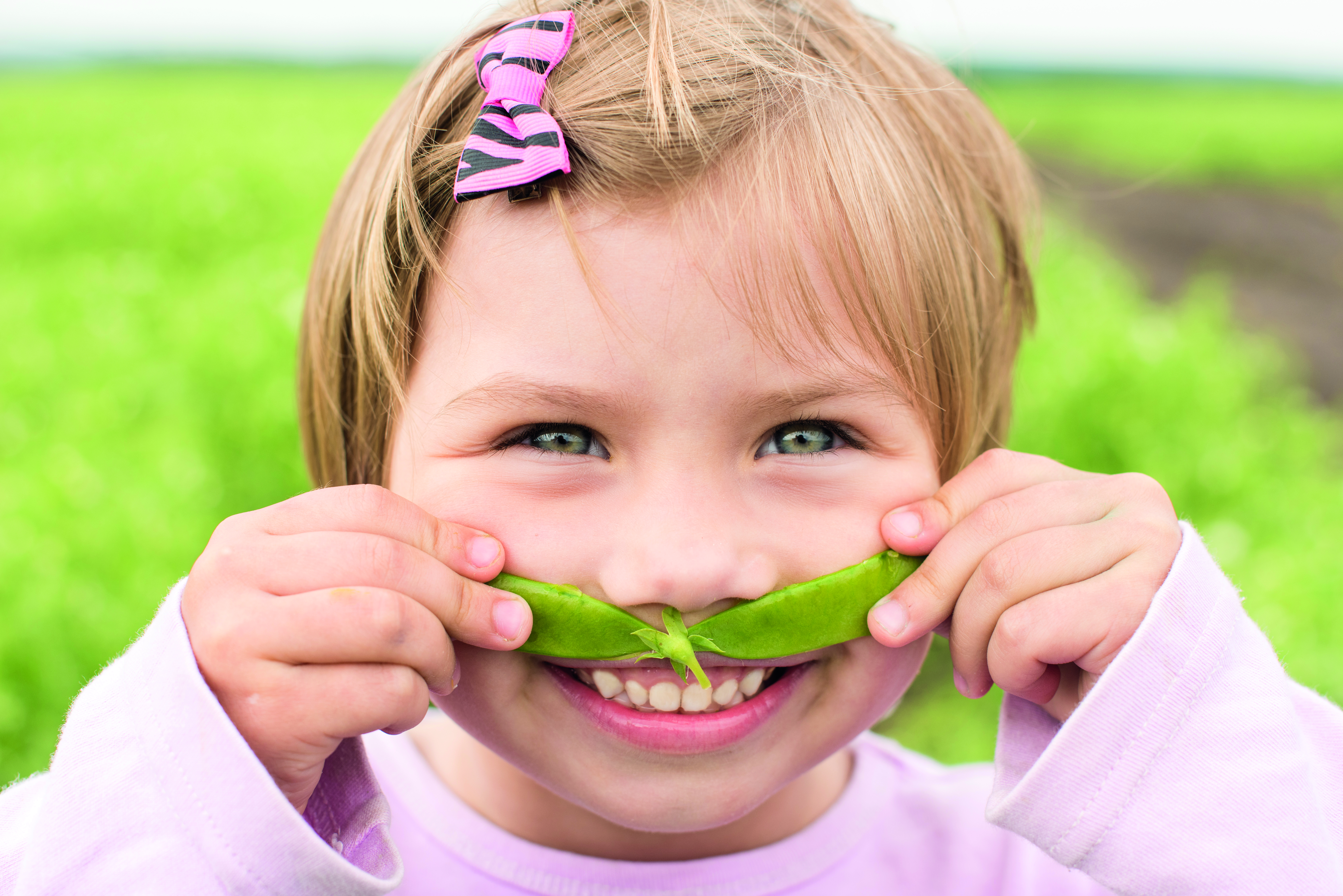
Charles Darwin believed children’s laughter to be the early appreciation of humour. But when and why do young people develop humour, and what can it tell us about their development?
In 2018, the Daily Mirror reported that an ultrasound scan at 30 weeks of pregnancy showed a foetus smiling in the womb. While never disproved, this is admittedly rare. Usually, scientists have found, a baby will smile in its first few months, and laughter will follow soon afterwards.
Caspar Addyman, psychology lecturer at Goldsmiths, University of London, explains, ‘There is a huge amount of variability, but smiling does come first. A smile will come in the first month or two, then the first laugh at around three or four months. Less than 0.1 per cent of parents say that by 18 months their child has never laughed.’
A baby’s early smiles are often downplayed as accidents or coincidences, but Dr Addyman disagrees. ‘The old explanation is that those first smiles don’t mean anything – the baby just has trapped wind or something. But parents don’t believe that, and I tend to believe them,’ he says. ‘We most often found these early smiles to be deliberate smiles of contentment.’
For the under-twos, parents identified the reasons their baby was smiling as:
- a response to pleasing things
- feelings of excitement
- a sense of surprise.
Later, at around four months old, the first examples of hysterical laughter were observed. ‘Once a child can laugh, it seems they can laugh quite substantially,’ Dr Addyman notes.

TYPES OF HUMOUR
The development of humour, and its causes and meanings, are the subject of much academic and practical discussion. There are various types of humour, all of which young children may come to enjoy or appreciate to some degree. They include:
- teasing or clowning
- incongruity
- pretending
- irony and sarcasm.
Children are alert to these possibilities from an early age, explains Romina Angeleri, a lecturer in psychology at the University of New Mexico.
‘Studies based on observations in natural contexts, such as family and daycare, have shown how much infants enjoy to interact in a humorous way,’ she explains.
‘Even when they are not yet able to tell or understand more sophisticated and complex forms of verbal humour, like irony and sarcasm, infants are extremely sensitive to the communicative context, and they can quickly understand when something “funny” is going on.’
Teasing
One of the earliest forms of humour displayed by young children comes from clowning or teasing, says Dr Angeleri. Children as young as three months make funny faces and sounds that make adults smile or laugh.
As children gain more control over their actions, they start to recognise behaviour that they can use intentionally to elicit laughter, such as copying a parent blowing raspberries, and, between five and nine months, they start to imitate adults more deliberately.
‘In the first year of life, infants actively try to engage adults in humorous exchanges and make them laugh, by teasing them or making “clown” faces,’ Dr Angeleri explains.
At some point in the first year, this may extend to pushing over a tower made by a sibling, or lifting up a top to show off a stomach. Significantly, these behaviours invite a response from someone else. Through humour, children start to show early awareness of others, and a desire to find common ground.
Researchers Vasudevi Reddy and Gina Mireault found this interest in others’ emotional reactions to clowning and teasing was often lower in children with developmental disorders, such as autism.
Incongruity
The majority of children understand relatively quickly when something ‘funny’ is going on; however, most notably through incongruity, when something like an event, face or puppet is odd, unexpected or unusual, like an adult putting a bowl on their head or waddling like a penguin.
Rather than expressing fear or confusion, children’s humour develops based on an element of surprise, and an understanding that something is intentionally wrong. This shows they are starting to master a basic knowledge of rules and patterns, and tells us something about their developing expectations, explains Dr Angeleri.
‘They can be surprised when their mum fails to reappear in a peek-a-boo game, or when someone slips on a banana peel, and they respond to these incongruities with humour, not with other possible emotions like astonishment or fear,’ she says.
Dr Addyman agrees, ‘From our research, parents’ experiences completely reject Freud’s theory that laughter is used to reduce internal tensions, like fear, in children.’
Pretending
By the beginning of their second year, children usually start to show the ability to pretend, using their imagination to treat objects as if they were something else, such as cuddling a ball like a baby, or holding a shoe like a phone, and, in a continuation from incongruity, find humour in this ‘wrongness’.
‘Early forms of humour can also say something about the ability of children to construct symbolic representations of reality, as in pretend play,’ explains Dr Angeleri. ‘This is very new and exciting for them, and the route to many other forms of humour.’
Irony
Researchers have also studied children’s ability to understand more complex types of humour, such as irony and sarcasm. Evidence indicates that children begin to understand some aspects of irony between five and six years of age, and their understanding continues to develop during middle childhood.
However, some studies suggest that even children younger than five occasionally use irony in everyday conversations.
Dr Angeleri says her research found a three-and-a-half-year-old girl who had not finished her dinner and, pointing to the full plate, said, ‘Mum, I ate everything: what you see here is just a big crumb!’
‘In this case, it was obvious to both the mother and the girl that the plate was still full, but the child used humour to avoid being chided,’ Dr Angeleri says.
She adds that the development of irony in young children can be linked to that of theory of mind, or the ability to understand and infer their own beliefs and intentions as well as those of others.
‘Disentangling the relationship between theory of mind abilities, language development and understanding of irony is challenging, but also a fascinating direction for research,’ she says.
When it comes to irony, Dr Angeleri suggests, ‘It is possible that, when children are in their everyday environment, humour begins to appear much earlier than we believe.’

THE SOCIAL SIDE OF HUMOUR
This emphasis on location in an ‘everyday environment’ is significant. At any age, it appears that most displays of humour are strongly dependent on feeling comfortable and relaxed and, above all, in good company.
Dr Addyman says even very young babies have to be with someone familiar before they will laugh. ‘Even tickling doesn’t always work. They have to be in a relaxed state before you are going to get laughter,’ he explains.
This links to theories that humour and laughter are forms of ‘social glue’ used to establish and strengthen bonds between people, rather than purely markers of individual enjoyment. American neuroscientist Robert Provine found that most instances of laughter in adults were found not in response to overt humour but, instead, in an effort to strengthen social bonds.
Dr Addyman has found the same is largely true in under-twos. ‘Initial prompts for laughter in adults are found in babies too, and they are often about when they are happy and have social interaction,’ he says.
‘For adults, laughter is used to bind a group together. This is even more the case with young babies, who find a lot of pleasure and enjoyment in seeing a friendly face, for example.’
Laughter in children has been found to increase when they are with other people (see box, previous page).
Dr Addyman explains, ‘Laughter is led by a social dimension. Babies are fascinated by people from day one, and eager to interact. The amount they laugh can tell us how sociable they are, and it is often tied to being relatively outgoing.
‘Initially, I wondered why babies laughed, what the joke was, and what this would tell me about what they understood about the world. It seemed a good measure of understanding, but it turned out that was quite misleading,’ he explains. ‘You can still laugh if you don’t get the joke, and babies, like adults, often just join in with laughter.’
He adds, ‘Laughter is a social signal, and a positive signal. It says, “I am connecting with you, I am happy, and I am engaged with what we are doing.”’
IN THE NURSERY
With this in mind, laughter is something to be encouraged in a nursery setting. Laura Tallant, senior lecturer in early childhood education at Bath Spa University, explains, ‘Humour can be injected into daily routines to have a positive effect on children’s moods. This is not only valuable but could also help inspire children to think creatively, feed their curiosity, and nourish their motivation to learn.’
Encouraging humour could help not only children’s development, but partnerships with parents, too. Research has found that the physical stress response from mothers was naturally alerted by their child crying, but decelerated by smiling.
Francesca Cornwall, childhood studies lecturer at Staffordshire University, says, ‘It is our duty of care to work in partnership with parents and, empowered with knowledge on the physiological impact of exposure to smiles, it could be recommended that we should increase the instances and methods of sharing the smiles of children with their families.’
She adds that the links between shared laughs and smiles and ‘serve and return’ interactions make them particularly important to encourage in nursery settings.
Dr Cornwall recommends plotting a ‘giggle graph’ with the regularity and instances of smiles and laughter in a child’s day to be shared with parents later, along with anecdotes and photos of what made their child laugh.
However, Dr Tallant acknowledges there can be challenges to a practitioner’s sense of authority when providing opportunities for clowning- or incongruity-based humour to children.
‘Possibly the most challenging idea to solicit is for practitioners to provide opportunities for children to enjoy and feel empowered by the fallibility of adults,’ she warns. ‘This is challenging because, in exposing fallibility, practitioners may feel they risk losing children’s respect.’
However, she continues, ‘It is imperative that practitioners overcome any feelings of apprehension and thoughtfully provide opportunities for children to explore the notion of power-shifts within relationships by exposing them to humour that promotes “self-effacement.”’

Undesirable humour
There are, however, some levels at which humour may be undesirable in a setting. As well as to create and strengthen certain social bonds, Professor Provine found that adults used laughter to exclude others, and children often do the same.
Practitioners can be challenged by children who start to find humour in making fun of their peers. However, early years consultant Anne O’Connor advises ‘responding rather than reacting’ to a child using hurtful or exclusionary humour in settings.
‘What might the child be communicating through inappropriate, exclusionary or hurtful humour – about their stage of development, their well-being or discomfort, or their own experience of being mocked or laughed at, that we might need to respond to in different ways?’ she asks.
‘Making a big thing of it often isn’t the best way to react, though it can be difficult when it triggers our own social anxieties. Tuning into ourselves as well as the child and the context can help us respond in ways that support the child to learn how not to use humour in hurtful or inappropriate ways.’
Meanwhile, ‘toilet humour’ often sees children push the boundaries on what is deemed acceptable and, often, look for reactions from their peers or adults.
Ms O’Connor says this is nothing too concerning. ‘It’s something adults often think is inappropriate, but we all did it, and most children tend to grow out of it, eventually,’ she explains.
A MOVING TARGET
Dr Addyman agrees that humour is an ever-changing phenomenon in children.
‘We have looked at how easily or how quickly a baby laughs, but these measures don’t correlate with anything else very reliably. It is really always a moving target with babies, and what makes them laugh one day may not do the same again.’
Dr Addyman also explains that little can be concluded about a child’s future personality from what they find funny at a young age.
‘There is variability between serious and not so serious people, and we see that just as much in babies and young children as in adults. But it is not necessarily a predictor that they will always be that way,’ he says.
However, above all, he is convinced laughter is something we should encourage in children wherever possible. ‘Whatever is making children laugh, we should be doing more of, because they are getting something out of it,’ he says.
‘But we shouldn’t let the tail wag the dog. We cannot just focus on producing laughter in children but on doing interesting things with them. Then, hopefully, smiles and laughter will follow.’

HUMOUR experiment 1
Dr Caspar Addyman led an observation of how children aged between two and a half and four reacted to a funny cartoon.
His study found they laughed eight times as much when they were with another child than when they watched the cartoon on their own, even though they reported that the cartoon was just as funny in both situations.
However, the children didn’t laugh any more in a big group than they laughed when they were with just one other child. This suggested that laughter was not simply a contagious reaction but provided a ‘signal’ to any other person that was present.
When children watched the cartoon alone, they were keen to connect with someone else to share the humour, sometimes looking around to catch the researcher’s eye during funny moments.
Dr Addyman explained, ‘The main reason they were laughing was to communicate that they found this funny.’
HUMOUR experiment 2

A team of French scientists discovered using humour may help toddlers learn new tasks.
The study asked two groups of 18-month-olds to observe an adult using a tool to grab an out-of-reach toy. In one group, the adult simply played with the toy after retrieving it, but in the other group, the adult threw the toy immediately on the floor, creating an incongruity which made half the children in that group laugh.
The children who laughed at the adult were able to repeat the action themselves more successfully than those who didn’t. Why laughter seemed to be related to the toddlers’ ability to learn was not entirely clear, but the researchers suggested it could be linked to temperament.
‘In this case, it is not humour per se that may have facilitated learning, but that temperamentally “smiley” babies were more likely to engage with the environment, and therefore to attempt and succeed at the task,’ they said.
They added it could also be that ‘laughing babies’ have higher social skills or cognitive capacities, allowing them to interact more easily with others and making them more amenable to mimicking actions.
The authors also suggested that positive emotions, such as laughter or engaging well with a researcher, could increase dopamine levels in the brain, which in turn has a positive effect on learning.
‘Thus, the effect observed here might be a general effect due to positive emotion and not to humour or laughter per se,’ the authors said.
FURTHER READING
- Addyman C (2020)The Laughing Baby: The extraordinary science behind what makes babies happy. Unbound
- Angeleri R and Airenti G (2014) ‘The development of joke and irony understanding: a study with 3- to 6-year-old children’, Canadian Journal of Experimental Psychology, 68 (2), p133
- Esseily Ret al (2013) ‘Understanding the experimenter’s intention improves 16-month-olds’ observational learning of the use of a novel tool’, Cognitive Development, 28 (1), pp1-9
- Hoicka E and Gattis M (2008) ‘Do the wrong thing: How toddlers tell a joke from a mistake’, Cognitive Development, 23, pp180-190
- Provine RR (2001)Laughter: A Scientific Investigation. Penguin
- Reddy V and Mireault G (2015) ‘Teasing and clowning in infancy’, Current Biology, 25 (1), pp20-23
- www.nurseryworld.co.uk/features/article/a-unique-child-practice-in-pictures-you-re-joking
- www.bbc.com/future/article/20150728-why-do-babies-laugh-out-loud









